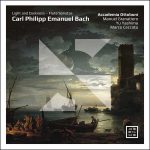

Composer: Johann Sebastian Bach
Performer: Pieter-Jan Belder
Format: FLAC (tracks)
Label: Brilliant Classics
Catalogue: 96065
Release: 2022
Size: 4.29 GB
Recovery: +3%
Scan: yes
01. Fantasie A Minor, BWV 922
Ouverture in F Major, BWV 820
02. I. Ouverture
03. II. Entrée
04. III. Menuet 1&2
05. IV. Bourrée
06. V. Gigue
Sonata in D Major, BWV 963
07. I. Allegro
08. II. Adagio
09. III. Fuga
10. IV. Adagio
11. V. Thema all’ imitatione Gallina Cucca
12. Fugue in D Minor, BWV 948
Suite in F Minor, BWV 823
13. I. Prélude
14. II. Sarabande en Rondeau
15. III. Gigue
Prelude and Fugue in B Minor on a Theme by Albinoni
16. I. Praeludium, BWV 923
17. II. Fuga, BWV 951
Praeludium et partita del tuono terza in F Major, BWV 833
18. I. Praeludium
19. II. Allemande
20. III. Courante
21. IV. Sarabande & Double
22. V. Air
Prelude and Fugue in A Major, BWV 896
23. I. Praeludium
24. II. Fuge
25. Capriccio in honorem Johann Christoph Bachii Ohrdruf in E Major, BWV 993
Capriccio sopra la lontananza del Fratello dilettissimo, BWV 992
26. I. Arioso, ist eine Schmeichelung der Freunde, um denselben von seiner Reise Abzuhalten
27. II. Ist eine Vorstellung unterschiedlicher Casuum, die ihm in der Fremde könnten Vorfallen
28. III. Adagiosissimo Ist ein allgemeines Lamento der Freunde
29. IV. Allhier kommen die Freunde, weil sie doch sehen, dass es anders nicht sein kann, und nehmen Abschied
30. V. Allegro Poco, aria del Postiglione
31. VI. Fuga all’ imitatione della Posta
Suite in A Major, BWV 832
32. I. Allemande
33. II. Air pour les Trompettes
34. III. Sarabande
35. IV. Bourrée
36. V. Gigue
37. Fugue in C Major, BWV 946 after Albinoni
Fantasia and Fugue in B Minor, BWV 951a on a Theme by Albinoni
38. I. Fantasia
39. II. Fuga
40. Fugue in A Major, BWV 950 on a Theme by Albinoni
41. Praeludium in C Minor, BWV 921
42. Fantasie in C Minor, BWV 1121
43. Sonata in A Minor, BWV 967
44. Fantasie in G Minor ‘in duobus subiectis’, BWV 917
45. Fugue in A Minor, BWV 947
46. Canzona in D Minor, BWV 588
47. Fugue in A Major, BWV 949
48. Praeludium in E-Flat Major, BWV 815
49. Fugue in B-Flat Major, BWV 955 on a Theme by Erselius
50. Aria variata, BWV 989
Sonata in D Minor, BWV 965 after Reincken
51. I. Adagio
52. II. Fuga
53. III. Adagio
54. IV. Presto
55. V. Allemande
56. VI. Courante
57. VII. Sarabande
58. VIII. Gigue
59. Fugue in B-Flat Major, BWV 954 on a Theme by Reincken
Sonate in C Major, BWV 966 after Reincken
60. I. Praeludium
61. II. Fuga
62. III. Adagio
63. IV. Allegro
64. V. Allemande
Praeludium, Fugue & Allegro in E-Flat Major, BWV 998
65. I. Praeludium
66. II. Fuge
67. III. Allegro
Over a career spanning more than 30 years, the Dutch harpsichordist and conductor Pieter-Jan Belder has become renowned as a Bach interpreter with his surveys in concert and on record of the keyboard and orchestral masterpieces such as The Well-Tempered Clavier, the Brandenburg Concertos and no fewer than three recordings of the Goldberg Variations.
On this album, recorded in 2020 and 2021 on a modern Titus Crijnen copy of a Ruckers model, Pieter-Jan Belder turns to the overlooked corners of Bach’s early writing for the harpsichord. These include standalone fugues, fantasias and suites based on themes by contemporary composers such as Reincken and Albinoni. Nevertheless, there is no sense of routine or technical exercise about them. The pieces here are almost all extrovert, playing to the strengths of the young Bach as a performer as well as composer, and already demonstrating that confidence which would go on to mark his mature compositions. An appreciation of French flair is discernible in the F minor Suite, BWV 823 and elsewhere, but the dominant influence is the keyboard writing of Girolamo Frescobaldi, whose toccatas and canzonas were studied by Bach from an early age.
The better-known pieces here include the sober and songful Aria variata, BWV 989 with its courtly French theme, and the E-flat Prelude, Fugue and Allegro originally written for lute, but which also finds a happy home on the harpsichord. The most famous but also most uncharacteristic piece is the mysterious Capriccio on the departure of a beloved brother which appears to be a work of Bach’s late teenage years, though no definite corroborative proof of its commission or purpose has yet come to light. Rather, it seems unique in Bach’s output as a humorous parody of styles and emotions.



